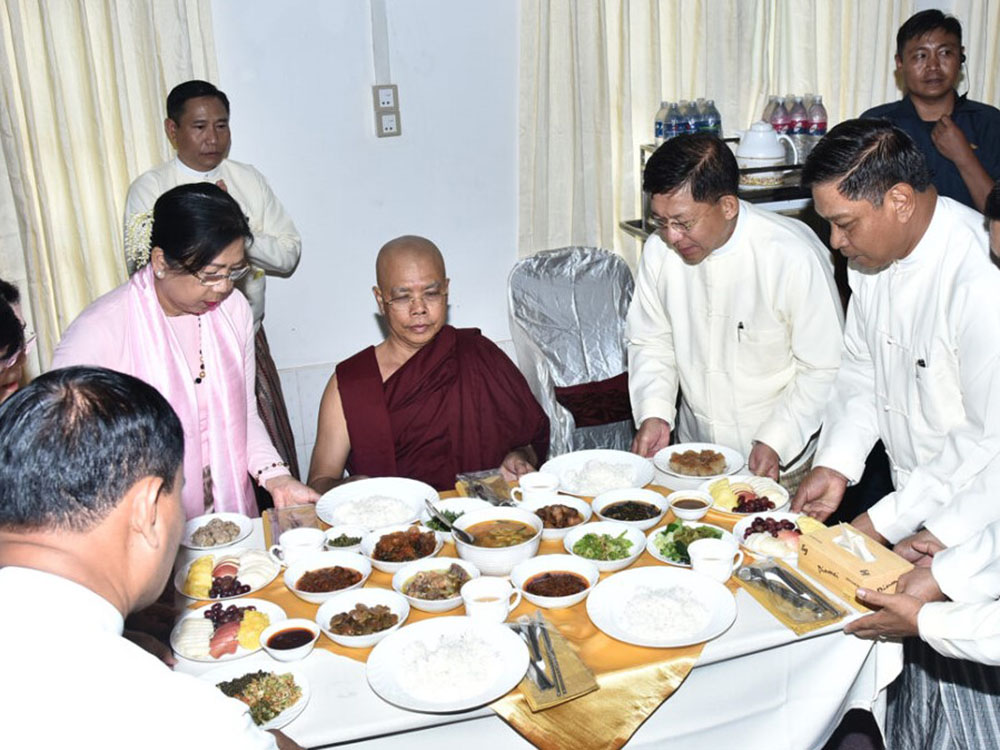The brutality of Myanmar’s junta has unmasked the generals in command but also influential Buddhist monks who were previously revered as significant religious figures.
Ashin Chekinda was known for his Buddhist programs for teenagers during the holidays, attracting hundreds of youngsters annually. He has failed to criticize the junta’s brutal crackdowns on peaceful protesters, some of whom are the same age as his students.
His relationship with National League for Democracy (NLD) leaders, including Daw Aung San Suu Kyi, was poor while the party was in power.
In July 2020, an embankment broke on the Ayeyarwady River in Amarapura Township, Mandalay. Then monk Ashin Chekinda attended as Mandalay City Development Committee officials were fixing the embankment at night. The monk castigated the NLD’s Mandalay mayor Dr. Ye Lwin, who was watching the work. The monk said he had come “for the sake of the people”, in contrast with the mayor.
The monk now heads the International Theravada Buddhist Missionary University in Yangon and publicly supports the junta, failing to condemn its many atrocities.
He was silent when the regime set fire to houses and killed civilians in Sagaing, his hometown, and he often attends the junta’s religious ceremonies. He also accompanied regime leader Min Aung Hlaing to Moscow in July to consecrate a replica pagoda.

Sitagu Sayadaw Ashin Nyanissara and Ashin Chekinda reportedly called on Min Aung Hlaing ahead of the 2020 general election for a coup. He wrote to Min Aung Hlaing, urging him to stage a coup, according to a respected monk who has followers in the military and the ousted NLD government. Ties with Min Aung Hlaing have deepened since the coup.
Ashin Chekinda was known for his Buddhist programs for teenagers during the holidays, attracting hundreds of youngsters annually. He has failed to criticize the junta since the coup.
He has close ties to military officers and told them to treat the former president U Thein Sein, an ex-general, as a father figure. In July 2015 he told officers to keep the former president’s footprints “as your father’s” during a ceremony to unveil a statue of Athinkaya Saw Yun, the founder of the Sagaing kingdom.
A monk who attended the ceremony said: “Ashin Chekinda told generals to keep their father’s footsteps. Some officers said their fathers had passed away. So he asked if U Thein Sein, who was a former general, had been like a father to them and the officers agreed. He told them to keep the footprints of U Thein Sein.”
Bamar custom says the footprints of mothers should be kept in appreciation of maternal love but it is rare to keep a father’s footprints and Ashin Chekinda’s comments surprised many.
The pair were close and U Thein Sein’s grandchild attended Ashin Chekinda’s holiday school.
U Thein Sein and Ashin Chekinda discussed the formation of a religious organization, which resulted in the nationalist, extremist Patriotic Association of Myanmar, also known by its Burmese acronym Ma Ba Tha.
Ashin Chekinda invited monks who took part in the 2007 Saffron Revolution against the previous military regime and several scholars to his monastery in Hmawbi, Yangon. U Thein Sein offered to fund monasteries that joined the association and pay for building repairs.
A monk from the Saffron Revolution Network said: “He didn’t say what he discussed with U Thein Sein but Ma Ba Tha was a political organization to win votes for the [military-proxy] Union Solidarity and Development Party. So we didn’t join.”
After failing to win over many of the monks who had protested against the regime, Ashin Chekinda widened the invitation to monks from across Myanmar.
While the Ma Ba Tha won global notoriety for its anti-Muslim hate speech, Ashin Chekinda, who was responsible for its creation, remained behind the curtain. And he even managed to bolster his image through charity work.
His ties with the military have grown stronger since the coup.
Soldiers from the Fourth Military Operations Command in Yangon clean his monastery in Hmawbi every weekend on the orders of their commanders.
Few soldiers were happy with the forced labor, said former captain Htet Myat, who defected after the 2021 coup.
Officers took temporary monkhood at Ashin Chekinda’s monastery and made donations. Generals and tycoons often met each other at the monastery.
In return business owners donated cash and cars to the monk. Ashin Chekinda arranged a government meeting for a businessman in Myeik Township, Tanintharyi Region, over a power supply contract. In return, the businessman paid for a foreign trip for the monk.
Born in Sagaing, Ashin Chekinda is not a “nge phyu” who has been in a religious order since the age of 18, when a teenager can choose to become a monk. He received a diploma in civil engineering from the Mandalay Institute of Technology before becoming a monk at 25 in 1983.
Ashin Chekinda reportedly owns the Taw Win Nan guesthouse beside the Ayeyarwady River in Sagaing and a gold shop. The businesses are managed by his nieces and a nephew.
A former student said Ashin Chekinda often told his teenage students and temporarily ordained monks that Myanmar’s democracy is a monarchy that the military had to take over because of the civil war under the parliamentary democracy of the early 1960s.
But he has been tight-lipped when the regime set fire to houses and killed civilians in Sagaing, his hometown. And he has often attended the religious ceremonies held by the junta leader. He accompanied Min Aung Hlaing to Moscow in July to consecrate a pagoda replica.

















